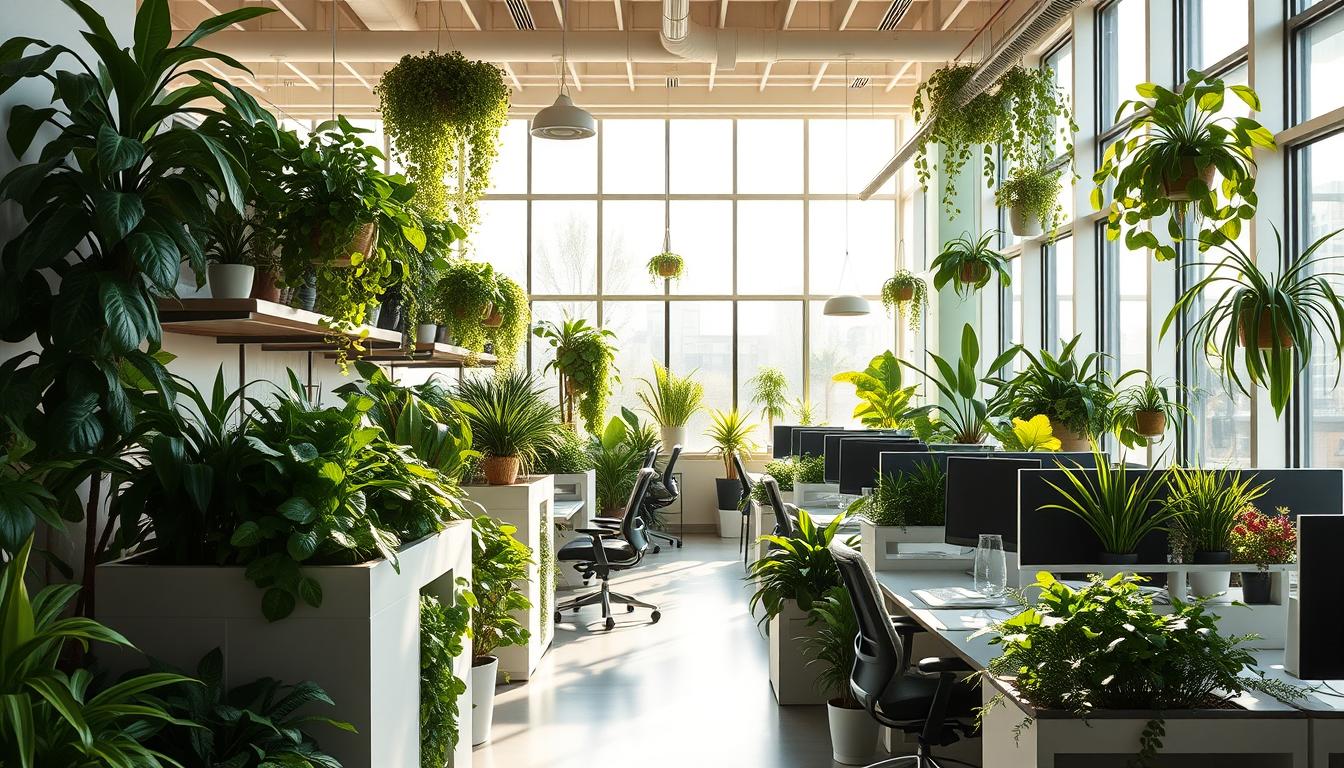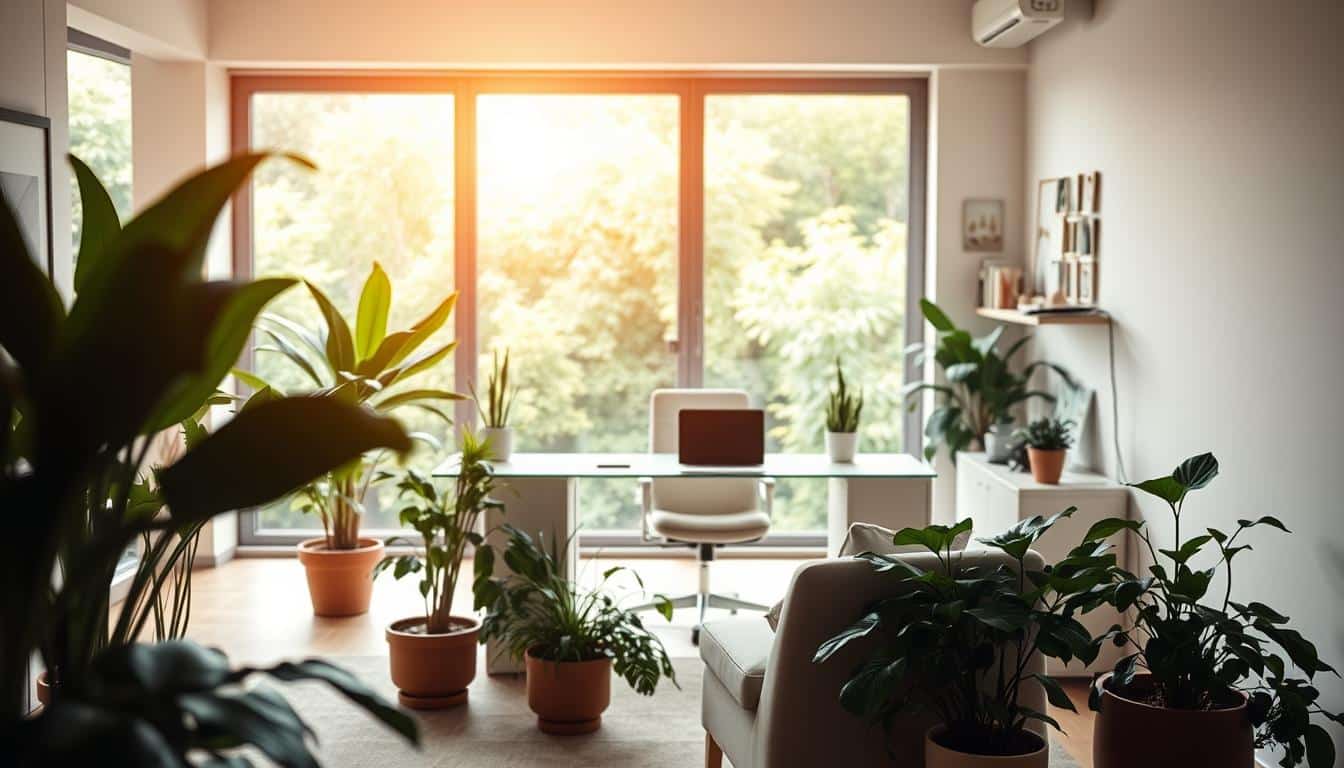In today’s work settings, making indoor air better is very important. Office plants do more than look nice. They act as natural air cleaners. They help in removing harmful VOCs from the air. Volatile Organic Compounds (VOCs) are found in paints, carpets, and office gear. They are not good for our health.
By choosing the right houseplants, we can make workspaces healthier. These plants have special abilities to clean the air. As we learn more about the bad effects of air pollution inside, it’s clear. Using office plants to clean the air is very important.
Understanding VOCs and Their Impact on Indoor Air Quality
Volatile organic compounds, or VOCs, impact indoor air quality. They are in many everyday items, polluting the air in enclosed spaces. It’s key to know about VOCs, where they come from, and the health risks they bring. This knowledge helps keep indoor environments healthier.
What Are Volatile Organic Compounds (VOCs)?
VOCs are organic chemicals that turn into gas easily at room temperature. This causes them to evaporate quickly into the air. VOCs include substances like formaldehyde and benzene, found in household products. They affect the quality of air inside homes and workspaces.
Sources of VOCs in Office Environments
In offices, VOCs come from different sources, like:
- Paint
- Cleaning products
- Office furniture
- Adhesives
- Personal care products
Indoor VOC levels can be up to 10 times higher than outside. It’s crucial to know and manage these sources.
Health Risks Associated with VOC Exposure
Being around VOCs can cause health problems. Short-term, you might get headaches, feel dizzy, or have eye, nose, and throat irritation. Long-term, the risks include serious diseases like respiratory issues and cancer. This shows why good air quality indoors is important.

The Science Behind VOC Absorption by Office Plants
Air-purifying plants boost indoor air quality in fascinating ways. NASA’s late 1980s research showed how certain houseplants soak up volatile organic compounds (VOCs). This work laid the groundwork for further studies on how plants reduce pollution indoors.
Nasa’s Groundbreaking Research on Air-Purifying Plants
NASA found many houseplants could suck up VOCs well. They checked out different plants to see how they clean the air. This study connected plant health with cleaner environments and led to more research on how plants absorb VOCs.
How Plants Absorb VOCs Through Their Leaves and Roots
Plants have a unique way to capture VOCs with their leaves and roots. Leaves have tiny openings called stomata that grab these compounds. The roots work with good microbes to break down bad stuff. This helps make the air cleaner, so it’s smart to have plants in offices to lower pollution.
Common Office Plants Known for VOC Absorption
Having clean air indoors is key for a healthy office. Some plants are great at sucking up bad VOCs from the air. Let’s look at the best plants for making office air fresher.
Spider Plant and Its Benefits
The Spider Plant is awesome at taking out formaldehyde, xylene, and toluene. It loves places with not too much direct sun and can handle different indoor settings. Because it’s tough and cleans the air, many offices love having it around.
Snake Plant: A Resilient Air Purifier
The Snake Plant is super strong and great at cleaning the air of formaldehyde, benzene, and nitrogen oxides. It doesn’t need much light, so it’s perfect for office spaces.
Peace Lily: Beauty and Functionality Combined
The Peace Lily is not just pretty but also cleans the air. It tackles toxins like ammonia and trichloroethylene. With its beautiful white flowers, it makes offices both look and feel better.
Other Recommended Plants for Indoor Air Quality
- Aloe Vera: It’s soothing and also fights formaldehyde in the air.
- Boston Fern: This plant is great at grabbing pollutants and also helps keep the air moist.
Do Houseplants Really Improve Air Quality?
People are talking more and more about if houseplants make our air better. Studies show plants might change the air around us. But, we need to look closely at what research says since there are many studies out there.
Review of Available Research on Effectiveness
Many studies, like NASA’s early work, show that plants might clean the air by taking in bad stuff. But, recent findings in 2019 say it’s not that simple. For plants to really make a difference, you might need a lot of them, from 10 to 1,000 for each square meter.
Challenges of Real-World Applications vs. Laboratory Studies
Lab tests are in perfect conditions, which is not how our homes or offices are. They often miss other air pollutants we face every day. Plus, things like how air moves and mixed pollutants make it hard to say if plants really help in real life. This makes us wonder if plants can actually clean our air at home or work.
Why You Need More Than Just Plants for Cleaner Air
Houseplants help a lot with indoor air, but they’re not the only answer. To truly clean the air, you need multiple approaches. Adding natural and mechanical ventilation can greatly improve the air we breathe indoors.
The Role of Natural and Mechanical Ventilation
Opening windows and doors helps bring in fresh air, which lowers indoor pollutants. This is natural ventilation. Mechanical ventilation, however, involves using HVAC systems. They filter and condition the air to lessen harmful substances. Using both methods makes office air much healthier.
Using Air Purifiers Alongside Houseplants
Air purifiers add to what plants can do. They have HEPA and activated carbon filters, removing tiny particles and harmful gases from the air. When used with plants, they offer a full clean-air plan. This targets more pollutants effectively.
Maintaining Your Plants for Optimal VOC Absorption
Taking good care of your plants is key to maximizing their ability to soak up harmful volatile organic compounds (VOCs). Things like proper watering and keeping them dust-free are critical in caring for indoor plants. Following certain tips can make the perfect home for your plants.
Watering and Drainage Practices
Watering your plants the right way is essential for their health. Too much water can cause problems like root rot, making it hard for plants to clean the air. Here are some watering and drainage tips to follow:
- Check the soil moisture before watering to ensure it is dry at the top level.
- Utilize pots with drainage holes to allow excess water to escape.
- Use a moisture meter for more accurate readings on when to water.
- Water in the morning to reduce evaporation and promote absorption.
Cleaning Dust from Leaves to Enhance Air Purification
Leaves covered in dust can’t do their job of photosynthesis as well. Regularly removing dust is key for plants to work their best. To maintain optimal performance, follow these tips:
- Wipe leaves with a damp cloth to remove dust and debris gently.
- Use a soft brush to reach the undersides of the leaves.
- Infrequently shower your plants with lukewarm water to give them a thorough cleaning.
Potential Harms of Keeping Office Plants
While office plants bring many good things, we can’t ignore some risks. Knowing these risks can help us take care of plants better. This way, we can avoid bad effects on health and air quality.
Mold Growth Induced by Overwatering
One big issue with indoor plants is mold growth from too much water. This extra water makes a perfect place for mold to grow. It forms spores on the soil’s surface.
When these spores get into the air, they can lower the quality of indoor air. People who breathe in these spores might get breathing problems or allergies. This shows why it’s key to water plants just right.
Pests and Allergens Released by Certain Plants
Indoor plants can also bring pests into the office. Some plants attract bugs, which can hurt the plants and people too. Pest droppings can make allergies worse for some people.
Also, certain plants give off pollen or other substances that can cause allergies. Knowing about these allergens can make the office a nicer place for everyone.
Combining Office Plants with Other Air Quality Solutions
Adding plants to an office’s air quality plan helps a lot, especially when used with other methods. Tackling pollution where it starts and boosting airflow improves the air for workers.
Source Control: Reducing Pollution at Its Source
It’s vital to cut pollution in offices by managing its sources. This means using fewer materials that release VOCs, like certain paints and carpets. Choosing products with low emissions helps make the office air healthier.
Teaching staff to pick safe products is also key to fighting pollution.
Ventilation Strategies for Improved Air Quality
Good ventilation is key for clean air in the office. An effective system brings in fresh air and works well with the purifying power of plants. Keeping the air systems well-maintained ensures they’re working right.
Future of VOC Absorption by Office Plants
The future of cleaning air with office plants looks bright, thanks to new research and tech. Scientists are diving into ways to make indoor air better. This could mean we’ll see better ways to use plants indoors, making air healthier for everyone.
New Research Directions and Innovations
Looking ahead, research might dig into changing plants’ genes to clean the air better. New tech could boost how well plants soak up harmful air stuff. Together, better plants and new tech could make indoor air much cleaner.
Integrated Approaches to Indoor Environmental Quality
Innovation will come from both new plant types and smart combined methods. By mixing plants with high-tech filters, we can greatly enhance air quality. This mix could change how we keep air clean in offices and indoors.
Conclusion
Adding plants to offices helps absorb pollutants and improves air quality. These green additions beautify the space and bring health benefits by lowering harmful compounds. Greenery in the office can make employees feel better and work harder.
Yet, plants alone can’t clean the air. It’s important to also use good ventilation and air filters. Combining these with plants makes the air in offices healthier.
Companies now understand more about the importance of clean air. Office plants play a big role in making workspaces better and more welcoming. Using both nature and technology helps keep the workplace nice and productive for everyone.



